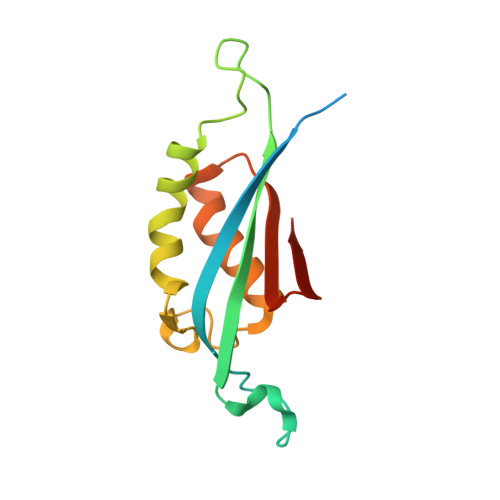Structural basis of a novel activity of bacterial 6-pyruvoyltetrahydropterin synthase homologues distinct from mammalian 6-pyruvoyltetrahydropterin synthase activity.
Seo, K.H., Zhuang, N., Park, Y.S., Park, K.H., Lee, K.H.(2014) Acta Crystallogr D Biol Crystallogr 70: 1212-1223
- PubMed: 24816091
- DOI: https://doi.org/10.1107/S1399004714002016
- Primary Citation of Related Structures:
3QN0, 3QN9, 3QNA - PubMed Abstract:
Escherichia coli 6-carboxytetrahydropterin synthase (eCTPS), a homologue of 6-pyruvoyltetrahydropterin synthase (PTPS), possesses a much stronger catalytic activity to cleave the side chain of sepiapterin in vitro compared with genuine PTPS activity and catalyzes the conversion of dihydroneopterin triphosphate to 6-carboxy-5,6,7,8-tetrahydropterin in vivo. Crystal structures of wild-type apo eCTPS and of a Cys27Ala mutant eCTPS complexed with sepiapterin have been determined to 2.3 and 2.5 ? resolution, respectively. The structures are highly conserved at the active site and the Zn(2+) binding site. However, comparison of the eCTPS structures with those of mammalian PTPS homologues revealed that two specific residues, Trp51 and Phe55, that are not found in mammalian PTPS keep the substrate bound by stacking it with their side chains. Replacement of these two residues by site-directed mutagenesis to the residues Met and Leu, which are only found in mammalian PTPS, converted eCTPS to the mammalian PTPS activity. These studies confirm that these two aromatic residues in eCTPS play an essential role in stabilizing the substrate and in the specific enzyme activity that differs from the original PTPS activity. These aromatic residues Trp51 and Phe55 are a key signature of bacterial PTPS enzymes that distinguish them from mammalian PTPS homologues.
Organizational Affiliation:
Plant Molecular Biology and Biotechnology Research Center (PMBBRC), Gyeongsang National University, Jinju 660-701, Republic of Korea.















